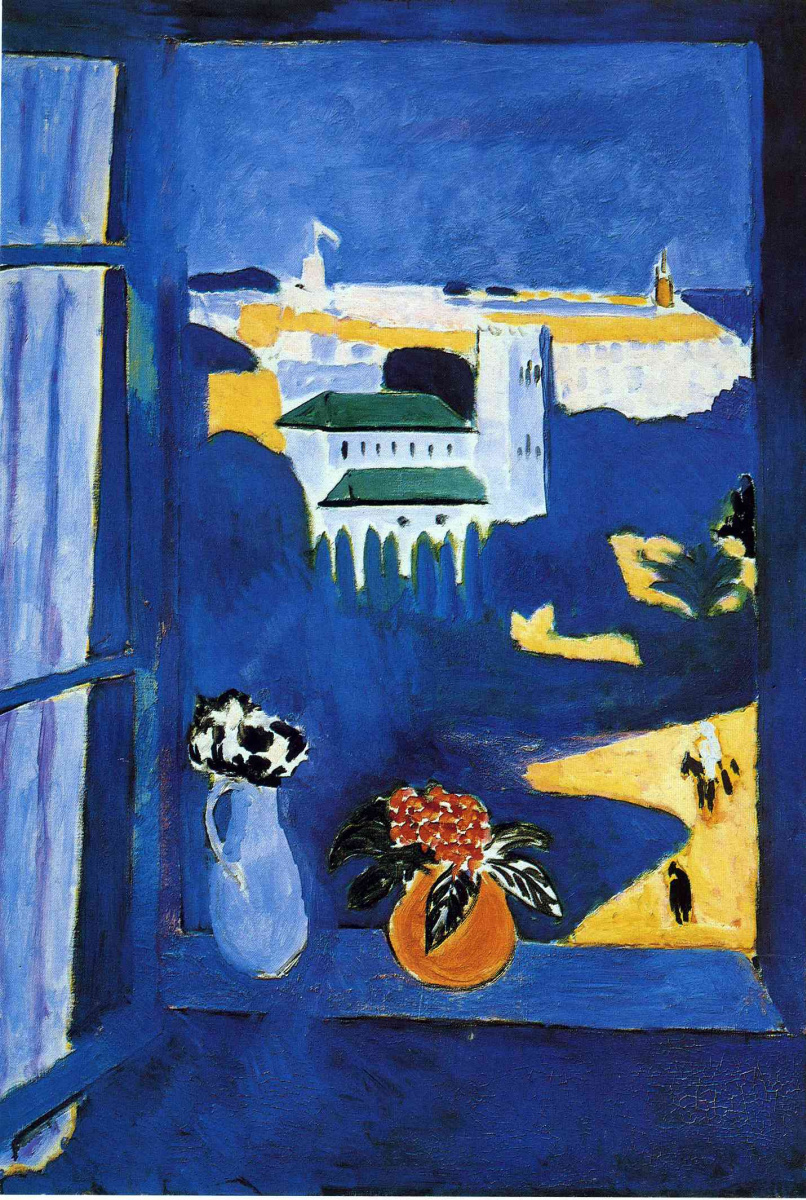log in
Enter site
Login to use Arthive functionality to the maximum
Window at Tangier
Henri Matisse • Painting, 1913, 115×80 cm
Description of the artwork «Window at Tangier»
In all his life, Matisse painted a great number of open windows. A view through an open window or a balcony is one of the most recognizable images in the French artist's work (1, 2, 3, 4). The painting Window at Tangier is the first part of Moroccan Triptych, which the artist created in 1912, while staying in Tangier.
Blue is the dominant colour in all these paintings (1, 2). There could be several reasons for this. Firstly, the walls of an old town seen from the window of the hotel room, where the Matisse lived, were white-blue. And when the blue colour of the skies and a bay emerged, it created a solid blue background.
Secondly, Moroccan Triptych evokes serenity and calmness, which were exactly those feelings sought by Matisse. "What I dream of is an art of balance, of purity and serenity,” he wrote, “devoid of troubling or depressing subject matter, an art which could be for every mental worker, for the businessman as well as the man of letters, for example, a soothing, calming influence on the mind, something like a good armchair which provides relaxation from physical fatigue."
The artist told Marcel Sembat, a politician and a journalist, that it was in Tangier, where he began to simplify paintings significantly and to strive for abstractions: “I move towards my feeling, toward ecstasy. Then too, it's how I find peace of mind. Then too, it's how I find peace of mind,” he said. A temperamental Sembat spoke expressively of the Matisse's aim: “Peace! He repeated it over and over again for many years. Peace is what he desires! Peace is what he needs! Peace is exactly what he wants to show! Matisse keeps sorrows to himself. He doesn’t want to show them to anybody. He shares only peace with people.”
Hilary Spurling, the author of the artist’s biography, explains his passionate desire for rest, depicted in the Moroccan series, by the disturbing events happened in Tangier during those days. When he was there, the tension between the local population and the French increased due to the signing of the treaty between the Sultan and France according to which the country became a patronage-state. Because of these events Matisse had to leave Morocco and while being in Paris, he found out that the dreadful slaughter organized by rebels led to the death of many French people who stayed in the city.
Fortunately, the artist managed to avoid conflicts and take all his works from the rebellious Tangier. Almost all of them moved to Russia and settled in the collections of Morozov and Shchukin. Marcel Sembat’s wife lamented a lot because of this, as she managed to buy only two pictures from the Moroccan series: "Soon, we will be able to see your paintings only in Moscow,” Georgette wrote to Matisse. “There are so many of them there, and the most remarkable. What if none of the French artists would never see them? It would be a great loss to the development of esthetic sense in France.”
Author: Natalia Azarenko
Blue is the dominant colour in all these paintings (1, 2). There could be several reasons for this. Firstly, the walls of an old town seen from the window of the hotel room, where the Matisse lived, were white-blue. And when the blue colour of the skies and a bay emerged, it created a solid blue background.
Secondly, Moroccan Triptych evokes serenity and calmness, which were exactly those feelings sought by Matisse. "What I dream of is an art of balance, of purity and serenity,” he wrote, “devoid of troubling or depressing subject matter, an art which could be for every mental worker, for the businessman as well as the man of letters, for example, a soothing, calming influence on the mind, something like a good armchair which provides relaxation from physical fatigue."
The artist told Marcel Sembat, a politician and a journalist, that it was in Tangier, where he began to simplify paintings significantly and to strive for abstractions: “I move towards my feeling, toward ecstasy. Then too, it's how I find peace of mind. Then too, it's how I find peace of mind,” he said. A temperamental Sembat spoke expressively of the Matisse's aim: “Peace! He repeated it over and over again for many years. Peace is what he desires! Peace is what he needs! Peace is exactly what he wants to show! Matisse keeps sorrows to himself. He doesn’t want to show them to anybody. He shares only peace with people.”
Hilary Spurling, the author of the artist’s biography, explains his passionate desire for rest, depicted in the Moroccan series, by the disturbing events happened in Tangier during those days. When he was there, the tension between the local population and the French increased due to the signing of the treaty between the Sultan and France according to which the country became a patronage-state. Because of these events Matisse had to leave Morocco and while being in Paris, he found out that the dreadful slaughter organized by rebels led to the death of many French people who stayed in the city.
Fortunately, the artist managed to avoid conflicts and take all his works from the rebellious Tangier. Almost all of them moved to Russia and settled in the collections of Morozov and Shchukin. Marcel Sembat’s wife lamented a lot because of this, as she managed to buy only two pictures from the Moroccan series: "Soon, we will be able to see your paintings only in Moscow,” Georgette wrote to Matisse. “There are so many of them there, and the most remarkable. What if none of the French artists would never see them? It would be a great loss to the development of esthetic sense in France.”
Author: Natalia Azarenko


